#les miserables 1948
Text
For this Barricade Day, I present to you one of the Most Unhinged Scenes I Have Ever Seen From a Les Mis Adaptation. It hails from I miserabili (1948) — perhaps the Les Mis adaptation with the highest amount of explosions in it — and I can only describe as a barrel chase scene in which barrels kill the National Guard and damn well near save the day.
And yes, Valjean did just punch a guy, probably Enjolras, (correction via @pilferingapples, it's Marius) out. And those barrels do seem to have malicious intent. And yes, that barrel shattered a whole building. And yes that guy did jump over the barrel like a Looney Tunes skit. And yes that was an explosion.
This is the single greatest scene in all Les Mis adaptations. Happy barricade day.
#Les Mis#les Miserables#Barricade Day#Valjean#Jean Valjean#I Miserabili#I Miserabili 1948#Les Mis 1948#Les Miserables 1948#1940s#video#BARRELS!!!!
375 notes
·
View notes
Quote
Other foreign productions [of Les Misérables] included [...] a memorable Italian version (1947) directed by Riccardo Freda [...]. This extremely expensive film included several thousand extras, and to give the barricades scenes greater realism, Freda pitched 'armies' of real-life Italian workers against squads of real-life students, some of them right-wingers. The mostly left-wing workers displayed considerable revolutionary zeal, and in the filmed mêlée, which got completely out of hand, sixty five extras were wounded.
— The Complete Book of Les Misérables, Edward Samuel Behr
...now that's authenticity
#les mis#les miserables#les mis text#les miserables 1948#my text#random les mis#the complete book of les misérables#i LIVE for this kind of stories#there's something about all things hugo that summons the weirdness#now i want a movie about the making of the italian film with parallels drawn between early 19th century france and fascist/post war italy
146 notes
·
View notes
Text

Everyone knows about the great 1909 double Les Mis battle but what about the 1948 vs 1952 debacle in the US?
24 notes
·
View notes
Text
Les Miserables 1948 pt 2 (a) : In Which Absolutely Nothing Will Be Explained
My previous review posts here: 1a and 1b
Warning that those posts, like this post, contain spoilers. Yes even if you've read Les Miserables. Especially if you've read Les Miserables. I really strongly advise not reading this post if you think you're gonna see this version soon because going in unspoilered was a treat.
That said, let's roll!!
The second half starts with the Amis!! They're all printing Illegal Materials and discussing the latest censorship laws!
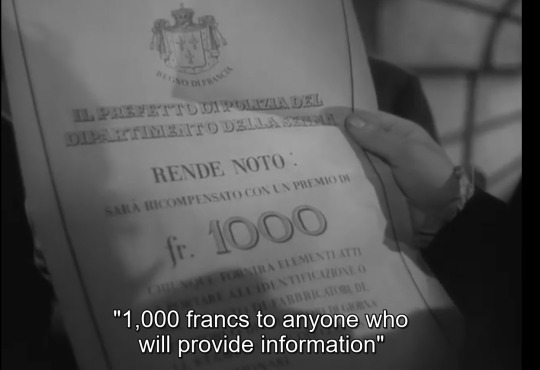

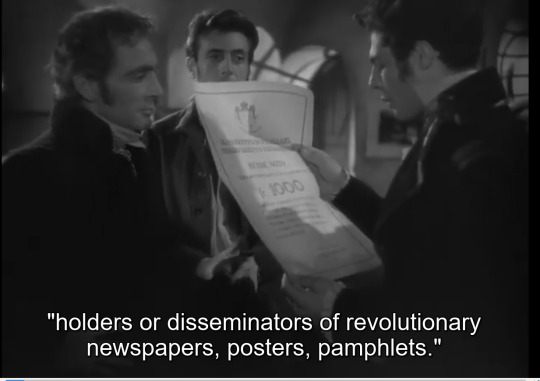
[ID: a group of photos of the Amis, young-ish men in surprisingly good 1830s outfits, reading a paper that offers "1,000 francs to anyone that will provide information likely to lead to the identification or arrest of the makers, holders, or disseminators of revolutionary newspapers, posters, pamphlets." /end ID]
Credit where credit's more than due: this is a fantastic way of introducing a large group of new characters and a new setting (wider Paris)! As they discuss their work, we learn more about them, their goals, and Parisian politics. Elegant and efficient! genuinely , I love this approach and wish more adaptations would do something like it
Unfortunately, while they do showcase several people doing various tasks, they don't name all of them--a shame, when it would have been so easy! But we do get to meet
Enjolras and Marius, the older leaders of the group! Here, Marius (left) is trying to get Enjolras (on the right) to leave Paris for his own safety (it does not work):

[ID: Marius tells Enjolras "And we must think, Enjolras, how you can get away from Paris for some time." /end ID]
Courfeyrac, a younger, clothes-focused revolutionary, and of course Gavroche:
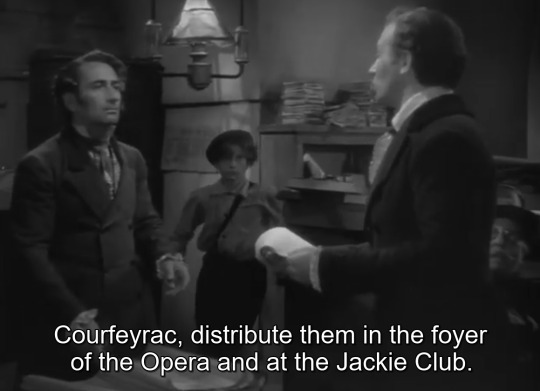
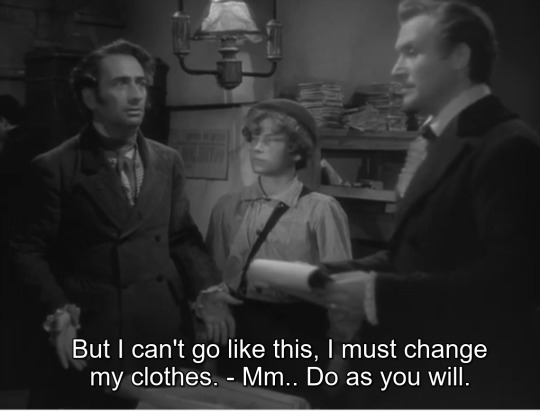
[ID: Enjolras brings Courfeyrac, a younger revolutionary, "Courfeyrac, distribute them in the foyer of the opera and at the Jackie club." Courfeyrac responds: "But I can't go like this, I must change my clothes. " Enjolras: "Mm...Do as you will." Gavroche, a kid about 10-12ish, watches this conversation./end ID]
and of course, everyone's favorite
tumblr's star of this show
GRANTAIRE!!!

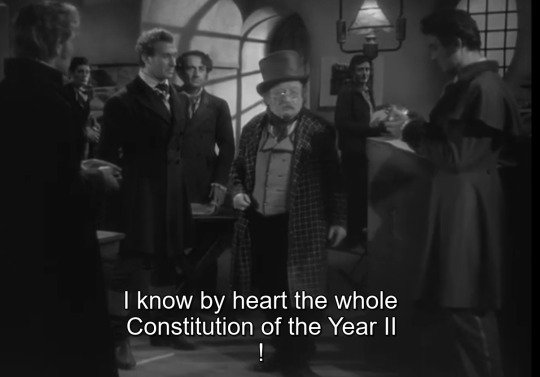
[ID: Closeup on Grantaire! a short, loudly dressed... 65 year old man?? saying " I know by heart the whole Constitution of the Year 2 ! "/ end ID ]]
I bet you do, 48! Grantaire! I bet you were there!
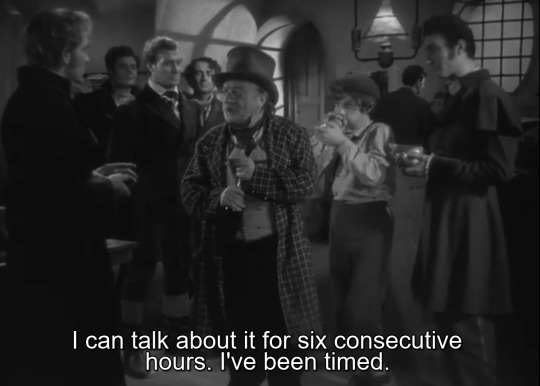
[ID: Grantaire brags that "I can talk about it for six consecutive hours. I've been timed. " while Gavroche prepares to burst a paper bag behind him. /end ID]
(Gavroche's relationship with this Grantaire so far delights me, in that it's mostly based on pranking him)
Were you ready?? I was not ready!!!
Anyway then the police break in and there's a SHOOTOUT and Marius escapes and runs through the streets of Paris and Cosette lets him into her and Valjean's house!! Marius flirts with Cosette by guessing that her favorite author is ANDRE CHENIER!! Valjean sends Marius some mixed messages by hiding him from the cops and then telling Marius to go away and then going to Marius' apartment to tell him to never try to see Cosette again and frankly,dude, a guy could think you were following him!
Oh yeah Marius' apartment is an inn run by the Thenardiers. Eponine is the general serving-girl there and he's just as conscious and careful of her feelings as he is in the book:
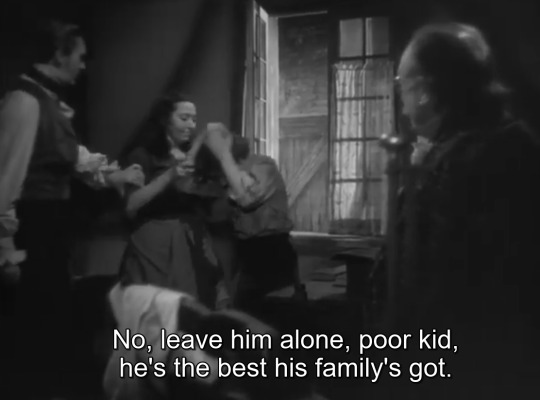
fckin OUCH
We also find out that Marius is living in the Thenardier's new inn on CREDIT?? Thenardier is just...bankrolling him?? WHY
(this will not be explained so just forget it)
Marius goes to meet Cosette (whose dresses, in keeping with this show, are Pretty Darn Good!)
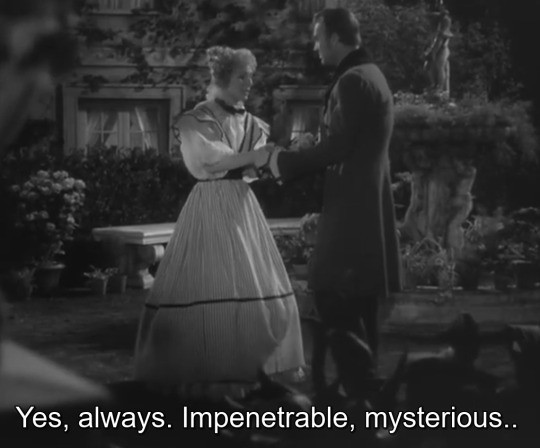
--and I have to say I think this show does a good job (so far!) with Valjean and Cosette's relationship! Yes, he's overprotective and keeps them too isolated-- but he does it out of concern rather than control, and she's not afraid of him, she trusts him and worries about hurting him, not being hurt by him, and he's always concerned for her safety and happiness above all. As she tells Marius in this scene, she never even noticed how isolated she was before-- she's been happy! I think they really get some of that Gothic haunted element around this house and Cosette's life , and it's great!
Marius leaves for the Revolution, telling Cosette to not worry for him (!) and Cosette goes inside and gets told there's a man waiting for her ??

[ID: Toussaint tells Cosette "He's in the hall, he was very insistent. He says his name is Baron Thenard." /end ID]
Thenardier tries to scam Cosette by pretending to be an old friend of her mom's
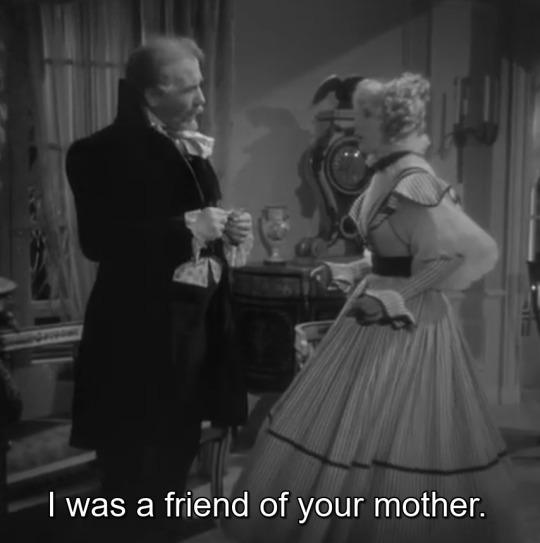
And it's actually a fantastic scene? Cosette reveals that she knows nothing of her past, and we can see how that's made her vulnerable; and we learn how desperate she is to learn more about the mother she can't remember.
I really like this move to make Thenardier Cosette's villain/nemesis, the haunt from her past! it makes so much sense , given...everything else up to this point...and gives her a chance for some excellent character moments!
Fortunately Valjean interrupts Thenardier's attempt to Scam Cosette! and then Valjean and Thenardier agree to meet at the Old Mill Thenardier Inn?!?
And then ..
ok what happens next should obviously be the Gorbeau Raid, except:
Marius has nothing to do with it. At all. Marius is not anywhere close to this, he's gone to join the Revolution, remember?
Eponine is not? there?
There is A LIGHTNING STORM for no reason?
VALJEAN HAS A GUN
the cops show up despite having absolutely no reason to??
I cannot usefully screencap this scene, its genius lies in its pacing, but also I am not sure how it's relevant anymore to the entire rest of the show! Kicking out Marius' Thenardier/ Napoleon issues kinda destroys half the relevance of the scene and Valjean and Thenardier already having acknowledged each other (and Thenardier knowing where he lives!) removes most of the rest. All we have left is FIGHT SCENE but then that's what this movie is about baby!!!
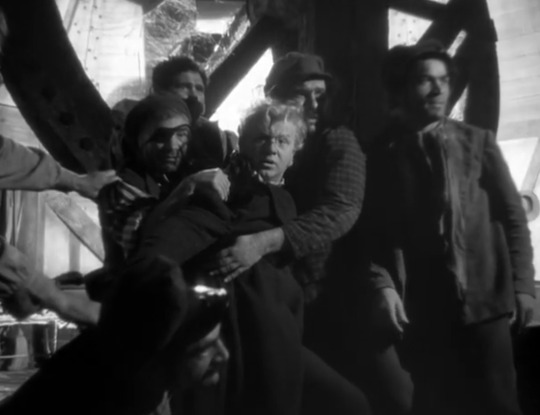
[ID: Valjean being embraced by the Patron Minette as they all try to avoid the police. No really, that's what's happening. /end ID]
I have no idea what's going to happen at the barricades! I am so excited!
#LM 1948#Les Miserables#Les Mis#other adaptations#I DIDN'T EVEN COVER GOVT. MINISTER GILLENORMAND#so many choices.
14 notes
·
View notes
Text
Un día como hoy…
Pero de 1948 moría André Bloch en París, Francia.
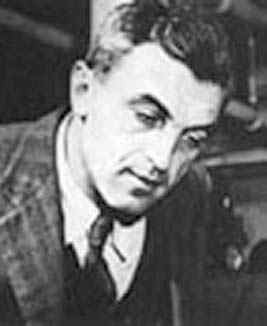
El señor Bloch fue un matemático francés que pasó a la posteridad por sus significativas contribuciones al análisis complejo. Pasó más de 30 años confinado en un hospital psiquiátrico a raíz de asesinar a su tío, tía y hermano; fue durante su confinamiento que produjo la mayor parte de su trabajo en Matemáticas.
Biografía
André era el mayor de 3 hermanos de un matrimonio de origen alsaciano y judío. Junto a su hermano menor, Georges, entró al lycée en Besançon donde su maestro de Matemáticas notó que ambos tenían un destacable talento para esta Ciencia.
Para 1913, Georges y André entraron a la École Polytechnique, pero el siguiente año se vieron forzados a unirse al ejército ante la explosión de la primera guerra mundial.
La guerra los marcaría más allá de remedio tanto mental como físicamente, y las heridas que consiguieron en su servicio harían imposible que fueran tomados en cuenta por el ejército en el futuro.
El 17 de noviembre de 1917, durante una comida familiar, André apuñaló a Georges, su tío y su tía. Tras el asesinato corrió por las calles gritando. No opuso resistencia al ser capturado. Solo reveló el motivo del crimen hasta pasado cierto tiempo, declarando que lo hizo para “cortar” una rama enferma del lado materno de su familia, aunque nunca tuvo la oportunidad de culminar su “labor eugenésica”.
Bloch fue internado en un hospital psiquiátrico. Según el testimonio de su psiquiatra, André no parecía sentirse miserable en lo absoluto al estar confinado en una institución mental; todo lo contrario, dedicaba la mayor parte de su día al estudio de las Matemáticas casi religiosamente, interrumpiendo sus estudios solo para comer y dormir. Su vida era rutinaria, pero parecía feliz dentro de su mundo de ecuaciones y símbolos.
Dentro de los temas de interés de André estaban la teoría de funciones, geometría, teoría de números, ecuaciones algebraicas y cinemática. Llegó a publicar numerosos artículos, pese a su confinamiento… o, tal vez, gracias a él.
Durante su estadía en el Hospital Saint-Maurice se subscribió a boletines y revistas especializadas en investigación matemática, al mismo tiempo que sostuvo correspondencia con notables matemáticos como Jacques Hadamard y Henri Cartan.
Durante la invasión a Francia en la segunda guerra mundial, dada su herencia judía, se vio obligado a publicar sus investigaciones bajo los pseudónimos de René Binaud y Marcel Segond.
Previo a su muerte, la Académie des Sciences le otorgó el Premio Becquerel. De todas sus contribuciones a las Matemáticas es famoso en especial por un teorema que lleva su nombre.
#André Bloch#Mathematics#History#History of Mathematics#Matemáticas#Historia#mathblr#studyblresp#studyblr español#no soy español pero pongo studyblr español porque soy un studyblr que comenta en español
2 notes
·
View notes
Text

Robert Mitchum and George Cooper Jr are in a clinch at the card table where Walter Brennan is seated in a 1953 re-release publicity still for Blood on the Moon (1948). George was born in Brooklyn and had 19 acting credits from Crossfire (1947) to a 1954 tv episode, with a final 1975 tv episode. His other notable credits include Dick Tracy Meets Gruesome, Les Miserables (1952) and Brigadoon.
3 notes
·
View notes
Text
La asociación mental de las cosas
Unir mentalmente dos elementos como Sionismo y Judaísmo, terrorismo e Islam, zurdos con pobres, derecha con ricos, etc., es una de las estrategias de las logias secretas. Yo pienso que lo mismo hacen con los símbolos religiosos, que los utilizan para que la gente asocie el ocultismo con las religiones. Y en realidad está diseñado para alejar a las personas de los templos. Porque una vez un "Sheij" (jeque) me dijo que se investigaron esas logias y que descubrieron que tenían los libros sagrados, como la Torá, la Biblia y el Corán. Por lo tanto, confundir a la gente y desorientarla es una forma de controlar su mente. La persuasión, la sugestión, la promoción, la incentivación, la instigación, el chantaje, la exhibición, etc., son herramientas que utilizan los ocultistas para hacerte creer que ellos tienen más poder del que poseen. Por empezar, alguien que necesita esconderse tiene una desventaja en el juego. Nosotros no necesitamos ocultarnos y eso es una ventaja. Por eso ellos necesitan vivir bajo falsas identidades o exhibir una personalidad que no tienen. Cuando yo hablo de que son personas que se ocultan, no quiero decir que no les ves el rostro, sino que no se muestran tal cual son ni dicen lo que hacen de forma secreta. Y eso es ocultarse. En cambio, hoy en día ya tienen bastante poder, porque la gente ya puede ver a varios de ellos, a través de sus símbolos.
El control de los medios masivos de comunicación es algo que los apasiona. Y por eso en Estados Unidos prohibieron Tik Tok, porque es una red social en donde cualquiera puede publicar un video y ser visto en todo el mundo. Y así muchos mostraban sobre la masacre de los palestinos en Gaza y al país del norte no le convenía para su imagen. Pero el Sionismo fue diseñado mucho antes de la creación del estado de Israel. Lo planificaron para ocasionar una guerra en Medio oriente, para desestabilizar la región. Y esa política te enseña cómo trabaja el enemigo, porque primero se hace tu amigo, como se hicieron los sionistas de los judíos, para después maltratarlos cuando no aceptaban matar a los palestinos; después, se adueñaron de Palestina y fueron trayendo colonos de todas partes del mundo. Incluso, cuando yo estudiaba Judaísmo, porque antes del Islam estuve en varias religiones, me ofrecieron para vivir allá, todo gratis, la tierra, todo. Por supuesto, con la condición de estudiar hebreo, y trabajar la tierra en un kibutz. Es decir, a cualquier rata miserable, que no tiene ni un peso en el bolsillo, le ofrecen vivir allá. Pero a mí no me dijeron la verdadera historia de Palestina, sino que la aprendi cuando me convertí al Islam. A mí nunca me interesó la política, sino que siempre busqué a Dios en las religiones.
Por eso, siguiendo el hilo de esta redacción, para el enemigo de la humanidad, trabajar la imagen, la apariencia, es lo más importante. Ellos mantienen una imagen de rectitud, de moralidad, pero esconden las peores monstruosidades. Y no sería de extrañar que muchísimos de ellos estén dentro de las religiones, disfrazados de santos. Y eso no quiere decir que no haya personas sinceras dentro de las religiones. Otra vez volvemos a la estrategia de unir dos elementos, como religioso con hipócrita. ¡No te olvides! ¿Cómo te enseñé sobre la forma en que operan? Recuerda el Sionismo y la historia de Palestina. ¿Qué hicieron al principio? Crearon el estado de Israel en el año 1948, haciéndose amigos de los judíos. Después controlaron todo; y por último, atacaron a los verderos judíos, los ortodoxos, tildándolos de antisemitas. Y lo mismo hacen en las religiones. Primero se hacen nuestros amigos, y estudian y saben más de religión que nosotros. Después tomaron el poder en varios países, en donde se aliaron a los sionistas. Y por último, el verdadero objetivo somos nosotros, los que somos verdaderamente religiosos. Y no me refiero a la imagen, porque la imagen de santidad que ellos trabajan no podemos igualarla. Nosotros somos reales, seamos desastrosos espiritualmente o lo que seamos. Es decir, no montamos una actuación, como hicieron los sionistas en Palestina. ¡Y qué lograron!, te preguntarás tú. La tierra de Palestina, que vale oro; puestos "ñoquis" de trabajo de los zurdos, que se hicieron amigos nuestros, haciéndose los pobres o utilizándonos para sus propósitos macabros. Lograron hacerle creer a la gente que los musulmanes somos terroristas; también, que cualquier religioso es un hipócrita. En fin... Debo ir a desayunar porque hoy me esperan dos colegios. Los simuladores, que dicen que lo más importante son los alumnos, cuando en realidad yo soy el blanco en donde apuntan; y otros, como yo.
No asocies dos elementos, porque esa es una táctica del enemigo: controlar tu mente, para dominar al mundo.
0 notes
Text
GERARD DEPARDIEU
1948
French actor
Gérard Depardieu is a French actor who has worked on stage and screen.
Depardieu was born in Chateauroux, Indre, France in poverty and left home aged 13 to work at numerous jobs and did petty crime. He moved to Paris and started acting on stage and then started acting on screen in 1975. Depardieu has appeared in: Green Card (1990), My father the Hero (1991), 1492: Conquest of Paradise (1992 as Christopher Columbus), Hamlet (1996), the Man in the Iron Mask (1998), Asteri & Obeli Take on Caesar (1999), Vatel (2000), Les Miserables (2000), Asterix & Obelix: Mission Cleopatra (2002), Nathalie (2003), les Rois Maudits (2005, Jacques de Molay), La vie en rose (2007), Raspoutine (2011, Grigori Rasputin), Life of Pi (2012), & Mata Hari (2017).
Depardieu has been married once and has four children, in 2008, his son died from pneumonia aged 37. Depardieu converted to Eastern Orthodox Christianity in 2020.
In 1998, he had a motorcycle accident due to drink driving. In 2000, he had heart bypass surgery after two weeks of suffering chest pains. Depardieu weighs around 150 kgs (300 lb.) in 2008. He has suffered at least seven motorcycle/scooter accidents during the 2000s, some of them attributed to alcohol. He said he drinks roughly around 12-14 bottles of alcohol a day, starting at 10am, champagne, wine, vodka, and whisky. In 2011, he was removed from a flight to Dublin after he urinated in front of passengers after being refused permission to use the toilet, when they plane was about to take-off. When he was told to sit down, he urinated into a bottle which had overflowed - his friend said it was due to him having prostate problems.
Depardieu has been accused of sexual assault and rape, in a 1978 interview he said - "too many (rapes) to count... There was nothing wrong with it. The girls wanted to be raped. I mean, there's no such thing as rape. It's only a matter of a girl putting herself in a situation where she wants to be." His publicity team had later stated that he had only witnessed rape.
Depardieu was granted Russian citizenship in 2013 which Vladimir Putin granted himself, in 2012 he stated he was handing back his French passport. In 2015 his films were banned from TV and cinemas in Ukraine due to his remarks questioning Ukraine’s right to exist. In 2022, he condemned Russian invasion of Ukraine and accused Putin of ‘crazy, unacceptable excesses’. In 2022, he stated he had become a citizen of United Arab Emirates.
In his spare time Depardieu invests in vineyards and owns numerous wine estates and also owns a restaurant. He owns the Tigne Castle in Anjou, and collects art and motorcycles.
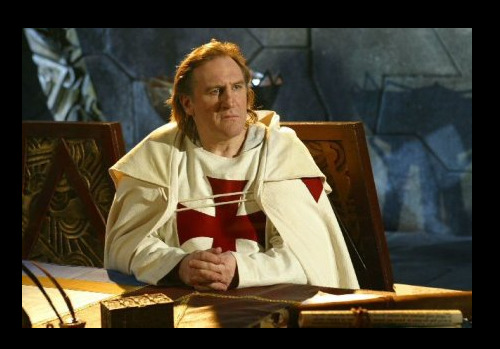
#gerarddepardieu
0 notes
Text
How Bicycle Thieves Represents the Italian Neorealism Movement
By: Julia Kusmenko
Among film history, World War II affected the styles of film around the world and people’s perspectives on cinema. One notable movement that emerged after World War II is Italian Neorealism. As stated in Torunn Haaland, “while defying conventions, neorealist film and fiction elaborate on the moral and social components of traditional realism.” In other words, Italian Neorealism analyzes the socio-political environment that influences the lives and wellbeing of a country’s people. A film that is representative of the Italian Neorealism movement is the 1948 film Bicycle Thieves which tells the story of a poor father named Antonio who must try tooth and nail to obtain a bicycle so he can do his job and support his family. After scrapping enough money together to buy a bicycle, Antonio gets his bike stolen within the first day of having the job. Antonio, his son and his friends search the entire city for the stolen bike but fall short. Antonio even finds the man who stole his bike but is unsuccessful in retrieving it. At his wits end, Antonio is driven to steal someone else’s bike at the end of the film but gets caught within minutes. Throughout this film, the hardships of daily life are presented through the turmoil experienced by Antonio and his family.
While much earlier in film history, this movie reminded me of the 1933 documentary Land of Bread in that the adults who lived in this impoverished town went to extensive lengths to try and feed their children. On the other hand, a contemporary movie that Bicycle Thieves relates to is the 2012 film Les Miserables since the main character Jean Valjean is poor and must steal bread in order to feed his family. The quote from Torunn Haaland’s book relates to Land of Bread and Les Miserables in that both films touch on the morality of the main characters but differs from these two films in that they do not pertain to the social components created by World War II.
Works Cited
Haaland, Torunn. “REALISM AND NEOREALISM.” Italian Neorealist Cinema, Edinburgh University Press, 2012, pp. 33–61. JSTOR, http://www.jstor.org/stable/10.3366/j.ctt3fgsn5.6. Accessed 17 Dec. 2023.
0 notes
Text
About this blog
This my history blog! I love history a lot, I don’t consider myself a history buff since I don’t know much, but I do love learning about it :D
what you might find here
history related stuff: fun facts, posts, analysis…
queer history: pictures, texts, etc…
folklore, mythology & legends: the tales, extracts, characters, analysis, origins, etc.
antiques & others: paintings, sculptures, photographies, clothing, utensils, letters/writing, music/music sheets, etc.
literature: extracts or quotes of classics, quotes of classical authors.
authors: stuff about artists, composers, writers, etc.
period dramas: tv shows, movies, anime, etc.
historical media: shows/movies based on true events.
old media: shows, movies and animations from before the 80’s.
academia aesthetics: dark, light, etc.
vibes: just things that, weirdly, feel quite or very old.
shows, movies & dramas
chernobyl
dead poets society
god of war
hamilton
jane austen’s adaptations
les miserables
little women
ragnarok (netflix)
the terror (s1, s2)
the song of achilles
when they see us
war movies (like «1948», «come and see», «all quite in the west front»…)
1 note
·
View note
Photo


LES MIS LETTERS IN ADAPTATION - Sister Simplice, LM 1.7.1 ( I miserabili 1948)
Sister Simplice was white, with a waxen pallor. Beside Sister Perpétue, she was the taper beside the candle. Vincent de Paul has divinely traced the features of the Sister of Charity in these admirable words, in which he mingles as much freedom as servitude: “They shall have for their convent only the house of the sick; for cell only a hired room; for chapel only their parish church; for cloister only the streets of the town and the wards of the hospitals; for enclosure only obedience; for gratings only the fear of God; for veil only modesty.” This ideal was realized in the living person of Sister Simplice: she had never been young, and it seemed as though she would never grow old. No one could have told Sister Simplice’s age. She was a person—we dare not say a woman—who was gentle, austere, well-bred, cold, and who had never lied. She was so gentle that she appeared fragile; but she was more solid than granite. She touched the unhappy with fingers that were charmingly pure and fine. There was, so to speak, silence in her speech; she said just what was necessary, and she possessed a tone of voice which would have equally edified a confessional or enchanted a drawing-room. This delicacy accommodated itself to the serge gown, finding in this harsh contact a continual reminder of heaven and of God. Let us emphasize one detail. Never to have lied, never to have said, for any interest whatever, even in indifference, any single thing which was not the truth, the sacred truth, was Sister Simplice’s distinctive trait; it was the accent of her virtue.
#LAB SCIENTIST SISTER SIMPLICE MY LOVE#Les Mis#les Mis Letters#LM 1.71#Les Miserables#I Miserabili 1948#I Mis 1948#Les Mis 1948#Les Miserables 1948#Sister Simplice#lesmisedit#lesmiserablesedit#imiserabili1948edit#filmedit#pureanonedits#Andreina Pagnani#Les Mis Letters in Adaptation
55 notes
·
View notes
Photo
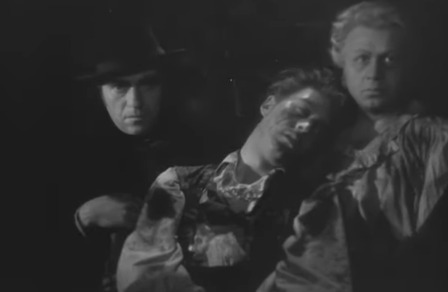
Personally not a fan of Les Mis 1948, but it does execute on the carriage scene like no other
#les miserables 1948#lm48#Does not come recommended unless you thought that Les Miserables was lacking in western shootouts and explosions and abusive jvj#Valjean snaps the neck of Cosettes doll in front of her while she's crying when shes like 6 which is. Almost like the book for sure!
19 notes
·
View notes
Photo

Michael Rennie and Robert Newton as Valjean and Javert in Lewis Milestone’s Les Misérables (1952) [source]
The Los Angeles Daily News, 5 February 1952
Remaking of an old film classic always results in many strange parallels and anecdotes.
Well, we dup up [sic?] an oddity out at 20th Century-Fox, where Lewis Milestone is directing "Les Miserables,” the daddy of all chase pictures.
It concerns the casting of Robert Newton and Sylvia Sidney in the Victor Hugo epic. Twenty three year ago, Newton, who had been introduced to Milestone by the late Robert Benchley, saw the actor in numerous plays which Newton produced at his own Schilling theater In London.
That same year Milestone met Newton again in New York, where the latter followed Laurence Olivier In the Broadway production of "Private Lives." After the play Milestone asked Newton to come to Hollywood to star in “The Life of Don Juan In America.” Newton came, but by that time the depression hit and the films financial backers pulled out. Now, after nearly two decades, Newton and Milestone finally working together.
It was the same year that Milestone, then with Howard Hughes, saw Sylvia Sidney In New York. He asked her to come to Hollywood to appear In "The Front Page” in the role of the girl who jumped out the window. But Ben Schulberg signed Sylvia to a long term contract, leaving Milestone to find another girl.
The other day Sylvia walked on the set of “Les Miserables” for the first time. Milestone said, "Welcome Sylvia, it took me 23 years to make a bad girl out of you.” He was, of course, referring to Sylvia’s role in the film -- that of Fantine.
'Les Miserable' still good
Milestone feels that this version of "Les Miserables” will be superior to the last film treatment, because it has both greater dramatic scope and is more compact -- somewhat of an achievement for screenwriter Richard Murphy, who wrote the 148-page script from Hugo's 1250-page immortal literary classic. Milestone points out that the timelessness of Hugo's work makes it Ideal film material. Its account of man’s inhumanity to man, of political as well as romantic strife, are as applicable today as they were back In 1816.
It is still, he says, one of the great suspense stories of all time, and the manhunt theme defies parallel. (The final chase through the sewers' of Paris has been the highlight of every "Les Miserables” made thus far.)
Darryl Zanuck made the last "Les Miserables” for 20th Century (not 20th Century - Fox that was just before the merger). It starred Frederic March as "Valjean" and Charles Laughton as “Javert.” The old Fox Films company made the first American version in 1917 with William Farnum as the hero and Hardie Kirkland as the French policeman assigned to track him down. Harry Bauer played "Valjean" in the French version In 1934 (Pathe-Naton). Lux Films made it in Italy In 1948 with Valentina Cortesa in the roles of both "Cosette" and "Fantine.” [. . .]
As usual, films like “Les Miserables” have their share of makeup problems. For example, Ben Nye toiled for many hours trying to get Rennie to look like Milestone’s conception of “Valjean.” Before Rennie made the grade he looked like everyone from Lincoln to one of the Smith Brothers. Finally, however, Nye captures Milestone’s desires and the result made Rennie almost unrecognizable.
In fact, one day Rennie’s lovely wife, London musical comedy star Margaret McGrath, visited the set during shooting of the galley sequence and had to have her husband pointed out to her.
“Gosh,” she remarked uninhibitedly, “am I married to THAT THING?”
9 notes
·
View notes
Text
#polls#les mis#les miserables#I'm really curious#I think anyone who's seen enough has a favorite Bad Adaptation#(mine is 48 but Bedtime Stories is CLOSE)
139 notes
·
View notes
Text
l know a lot of people complain about les mis bbc, but let’s all remember les mis 1948 where:
- Javert works for Marius’ father who is a magistrate in Paris
- Marius is worried Valjean is abusing Cosette. Valjean is actually treating Cosette horribly
- Valjean ends up basically killing Thenardier
- Marius stays at the Thenardier’s inn, which is where he meets Eponine (who works there)
- Javert is not even at the barricades
- But then, the barricades are basically a brawl in an inn
- Javert kills himself because Marius’ dad decided to forgive Jean Valjean and this apparently lets him understand that Valjean is a good guy (and this is just before Valjean decides to try and kill Thenardier)
also, this is Grantaire:
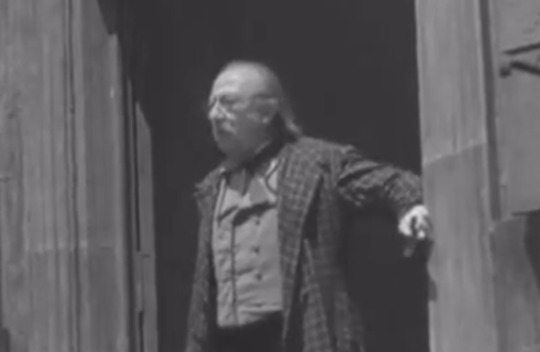
here with Enjolras before getting killed
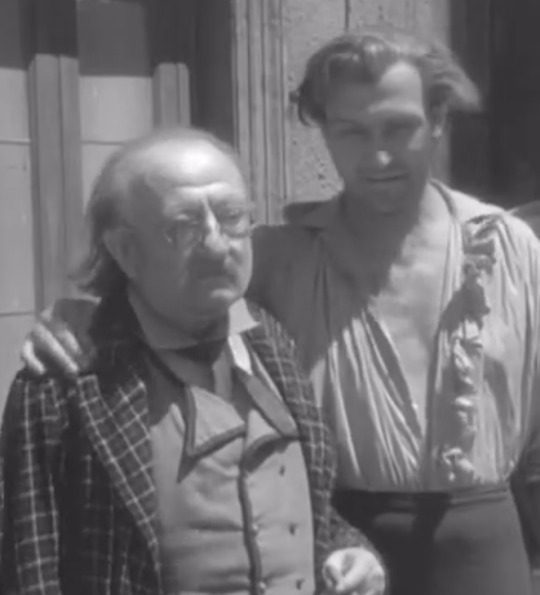
135 notes
·
View notes
Text
FAvorite adaptions of classic books with multiple adaptations
Favorite Alice's Adventures in Wonderland : Alice in Wonderland (1999)

Favorite Les Miserables: Les Miserables the musical

Favorite Three Muskateers : Three Muskateers 1948
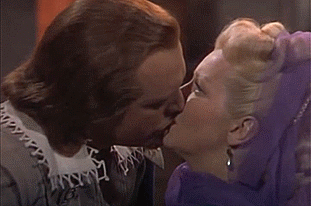
Favorite Frankenstein: Frankenstein 1931
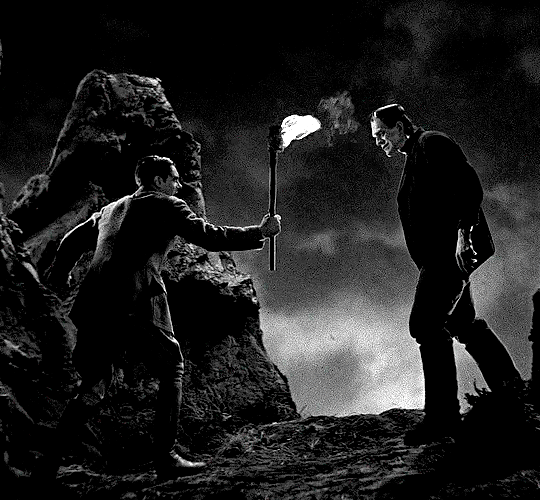
Favorite Christmas Carol : Scrooge (!970)
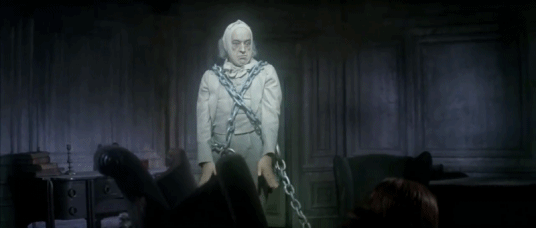
Favorite Dracula :Count Dracula 1977

Favorite Phantom of the Opera : The Phantom of the Opera 1943
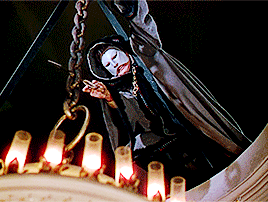
Favorite Jungle Book: Chuck Jones Jungle Book trilogy(Mowglis Brothers /Riki Tiki Tavi /White Seal ) 1975/1976

Favorite Treasure Island : Muppet Treasure Island (1996)

Favorite Wonderful Wizard of Oz :Wizard of Oz 1939

Feel free to do this (Also feel free to pick diffrent books with multiple adaptions if you aren famliar with the above stories )
@ariel-seagull-wings @princesssarisa @amalthea9 @the-blue-fairie @personofsinterest @metropolitan-mutant-of-ark @lord-antihero @professorlehnsherr-almashy
19 notes
·
View notes